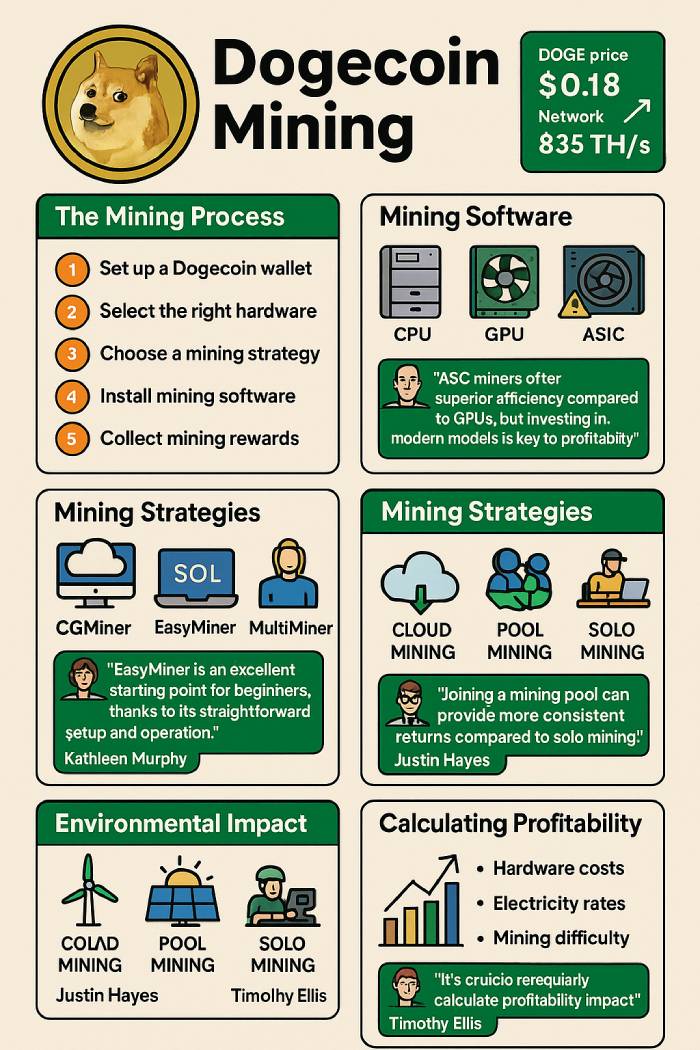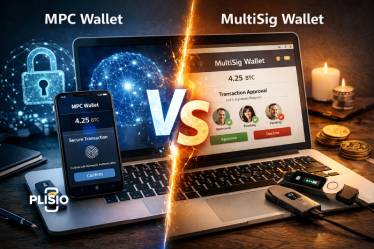Mine Dogecoin in 2026

Getting started with Dogecoin mining was once a straightforward task. In the early days, nearly anyone with a desktop computer, some available disk space, and a decent GPU could mine Dogecoin. But as the popularity of the coin surged, so did the total mining power across the Dogecoin network, significantly increasing mining difficulty and making it harder for solo miners to mine DOGE blocks.
To adapt, many began to join a mining pool — a collaborative effort where miners share computational resources and split rewards. These Dogecoin mining pools work similarly to those for other proof-of-work cryptocurrencies like Bitcoin and Litecoin. Pool mining makes the mining process more efficient and ensures a steady flow of mining rewards distributed fairly among participants.
In 2014, Dogecoin adopted merged mining with Litecoin, a breakthrough that allowed miners to mine DOGE and LTC simultaneously using the same mining hardware. Thanks to both coins operating on the Scrypt algorithm, merged mining has become an efficient strategy to boost mining profitability without additional resources.
Over time, Dogecoin mining has transitioned from being a hobby to a serious mining operation. Modern miners typically use ASIC miners — powerful devices engineered specifically for Scrypt-based cryptocurrencies. This specialized mining equipment has replaced most general-purpose GPU mining setups for those seeking consistent profitability within the Dogecoin blockchain.
As of mid-2025, Dogecoin maintains a network hashrate of around 820 TH/s, a steep rise from 320 TH/s at the start of 2024, reflecting growing interest in DOGE mining. The price of DOGE remains relatively strong, trading between $0.16 and $0.19, with a market capitalization of approximately $25 billion.
According to crypto analyst and miner Daniel Wescott, "Dogecoin’s appeal lies not only in its community but also in its reliable block rewards and relatively low entry costs compared to Bitcoin. With the right mining hardware and electricity conditions, DOGE remains a viable asset for consistent returns."
What You Need to Start Mining Dogecoin
To mine Dogecoin effectively today, you’ll need a suitable mining setup:
- A desktop or laptop computer (Windows, macOS, or Linux)
- At least one ASIC miner designed for Scrypt mining
- A stable and energy-efficient power supply
- Mining software compatible with your hardware
- A Dogecoin wallet (software wallet or hardware wallet)
- Membership in a reliable Dogecoin mining pool
- Access to affordable electricity (preferably under $0.10 per kWh)
Choosing the Right Mining Hardware
There are three categories of mining hardware suitable for Dogecoin:
- CPU Mining: Technically possible, but rarely profitable. CPU mining is inefficient and can overheat your computer.
- GPU Mining: Offers better performance than CPUs. Popular GPUs for mining DOGE include the NVIDIA RTX 4070, RX 7900 XT, and earlier models like GTX 1660 Ti. GPU mining is still viable for hobbyists in 2025, particularly when used for multi-coin strategies.
- ASIC Miners: The best option for serious DOGE mining. Top performers in 2025 include the Bitmain Antminer L9 (17.6 GH/s), Goldshell Mini DOGE III (735 MH/s), and Innosilicon A6+ LTCMaster (2.2 GH/s).
"The introduction of newer ASICs like the L9 series has leveled the playing field," says Julia Mendez, CTO at a European crypto mining consultancy. "While the initial investment is high, miners can recover costs faster if they manage heat and uptime efficiently."
Dogecoin Mining Software
To connect your mining hardware to the Dogecoin blockchain and begin earning rewards, you’ll need proper mining software. Leading options in 2025 include:
- CGMiner – best for ASIC miners
- EasyMiner – great for beginners
- CPUMiner – ideal for CPU mining
- CudaMiner – suitable for Nvidia GPUs
- MultiMiner – user-friendly for mixed hardware setups
"Optimization of mining software can increase efficiency by up to 12%," says Raj Patel, lead developer at an open-source mining project. "We’re seeing a shift towards AI-assisted tuning, especially in large-scale operations."
Dogecoin Wallets for Storing Rewards
Your Dogecoin wallet will receive your mining rewards. In 2025, top choices include:
- Software Wallets: Trust Wallet, Dogecoin Core, Exodus
- Hardware Wallets: Ledger Nano X, Trezor Model T
- Exchange Wallets: Binance, Kraken (use cautiously for short-term storage)
Mining Strategies: Solo mining, Pool mining, and Cloud Mining
When deciding how to mine Dogecoin, consider these approaches:
- Solo Mining: Full control and full rewards, but statistically difficult to achieve consistent block validation unless you operate at scale.
- Join a Mining Pool: Over 95% of miners participate in pools. Top DOGE mining pools by hashrate in 2025 include AntPool, Prohashing, F2Pool, and ViaBTC.
- Cloud Mining: Providers like NiceHash, Bitdeer, and Hashshiny offer DOGE cloud mining contracts, although profitability varies based on fees and DOGE price.

Crypto Mining Setup & Configuration
A reliable mining rig setup is essential:
- Connect ASIC miners to power supplies
- Use Ethernet for reliable network connectivity
- Assign static IPs for monitoring
- Access each ASIC via browser and input pool settings
- Monitor hashrate, temperature, and fan speeds
Optimizing Your Mining Equipment
With ASIC power usage exceeding 3,000W in top-tier units, cooling and energy efficiency are essential:
- Install intake/exhaust ventilation
- Use air conditioning in warmer climates
- Consider immersion cooling for large operations
- Schedule regular cleanings and firmware updates
Use of Renewable Energy
An estimated 28% of Scrypt-based mining operations now use renewable energy. Countries with abundant hydro and solar power, such as Canada, Sweden, and parts of South America, offer competitive electricity rates for Dogecoin miners.
"Green mining isn’t just about ethics anymore," says Elena Nowak, energy strategist at CryptoGrid. "As carbon regulations tighten, renewable-powered mining rigs could see cost advantages and even incentives from local governments."
Mining Profitability & Considerations
Key factors include:
- Mining difficulty: Adjusts every 240 blocks
- DOGE price: As of June 2025, hovering around $0.17
- Hardware efficiency: Measured in watts per megahash
- Electricity rate: Profitable mining generally requires power below $0.12/kWh
According to WhatToMine.com (June 2025), the Antminer L9 yields ~$3.50–$5.00 daily in DOGE, while the Goldshell Mini DOGE III brings in ~$0.90–$1.40/day depending on pool efficiency and electricity cost.
Is Dogecoin the Best Coin to Mine?
Dogecoin remains a strong contender due to:
- High block frequency (1 block per minute)
- Large and active community
- Stable merged mining with Litecoin
That said, other coins like Kaspa, Monero, and Nexa also show solid returns depending on market conditions and hardware compatibility.
"For mid-size miners, Dogecoin is attractive because of its stability and strong brand recognition," notes Arjun Mehra, crypto economist at ChainIQ. "It's easier to plan ROI over a 12-month period than with more volatile altcoins."
Cashout Strategy
In 2025, miners increasingly follow hybrid strategies:
- Convert 50% of mined DOGE to USDT or fiat
- HODL the remainder for long-term upside
- Track DOGE metrics using tools like CoinMarketCap, CoinGecko, and blockchain explorers
Join the Dogecoin Mining Community
For tips, troubleshooting, and updates, join:
- Reddit: r/dogecoin, r/dogemining, r/litecoinmining
- Discord: Dogecoin Official, Prohashing Pool Chat
- Twitter/X: Follow @dogecoin and major mining accounts
Conclusion
Dogecoin mining in 2025 is more competitive but still rewarding with the right mining hardware, low energy rates, and strategic setup. Whether you choose to mine solo, join a mining pool, or explore cloud mining, it's crucial to understand mining difficulty, network dynamics, and profitability drivers.
Start mining with purpose — and may your DOGE rewards multiply!




